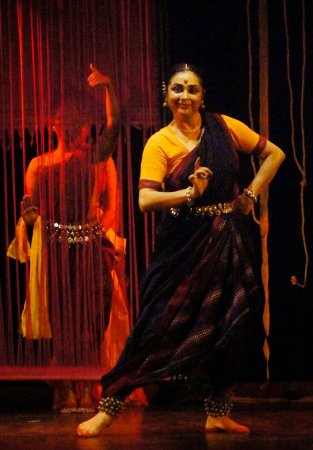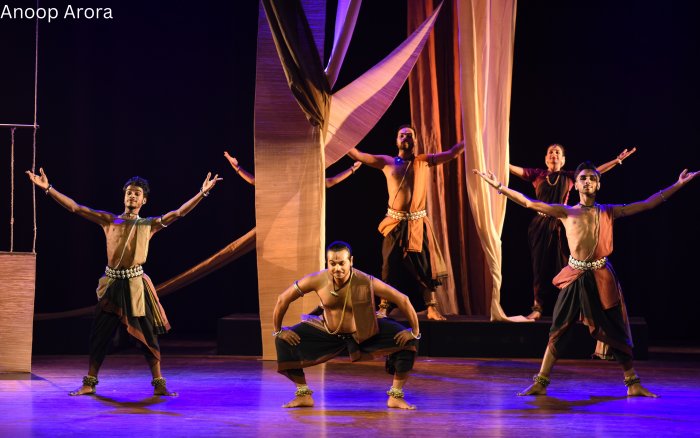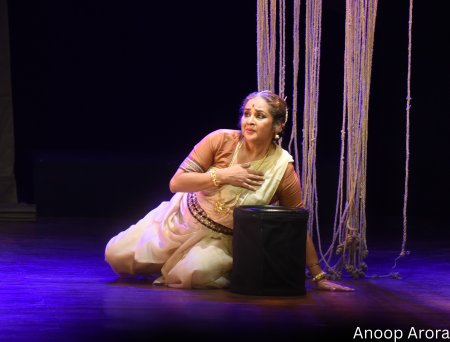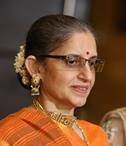
|
 |

|
 |
Sharmila Biswas on Manodarpan: Reflections of Life - Shveta Arora e-mail: arorashveta1806@gmail.com Photos: Anoop Arora March 21, 2025 I watched Guru Sharmila Biswas' thought-provoking 'Manodarpan: Reflections of Life' at Kamani in Delhi on 14 December and immediately wanted to talk to her about it. Sharmila Biswas is one of India's most renowned and much awarded senior Odissi exponents, responsible for some of the most lyrical, conceptually rich and intellectually stimulating Odissi productions I have watched over the years. 'Manodarpan' was no different, based on Natya Shastra shlokas and highlighting the various dramatic elements in performing arts in the context of bhava rasa. It presented how the Natya Shastra reveals the rasas that tell human stories of human experiences - anger, love, lamentation, power. The music direction was by Rajeswari Ganguly and it was performed by Sharmila Biswas, Krishnendu Saha, Koushik Das, Dipjoy Sarkar, Biswajit Mondal, Raaginni Hindocha and Saity Dey. In this conversation, Sharmila Biswas narrated how, like many of the interesting productions toured in the last two years, this one too emerged from artistic endeavours initiated during the COVID-19 lockdown that were not intended to be for performance. She elaborated on the interpretation of rasas (eight, not nine), stagecraft and aharya, angik and vachik, and how learning and immersion are critical to the development of her productions.  Ashtarasa, not navarasa Sharmila Biswas explained that the production used an early interpretation of the rasa in the Natya Shastra, in which shanta was not considered a rasa humans could produce. It was actually ashtarasa, not navarasa, because the first rasa theory in the Natya Shastra talked about eight rasas, not considering shanta. They thought that shanta was total neutrality, so there was no rasa in it and it is not something that any human can show. So, it was ashtarasa. How the concept, literature, choreography, stage design and music were developed Sharmila explained the angik, vachik, aharya of the production - the three things the Natya Shastra says are in the actor's control. First, I could do it only because of the lockdown situation; for myself and for my students, I thought it would be a great opportunity (to study the texts, including Natya Shastra) where one can do it online - learning about it without any of the usual "class way" of dealing with subjects. I had always felt that we have great information in our texts - or texts on performance all over the world - which are written. Whenever it's written, we say it's "theory". But it is not theory because these texts are absolutely performance related - they are intended to be practised. The Natya Shastra is to be interpreted and practised. So, I feel in these texts, as in the Natya Shastra, where the rules and codifications are written - just like grammar, which gives you guidelines on how to write literature - you have to transcreate. Otherwise, it becomes like chapters of a grammar book. Both are equally important. They support each other - grammar supports poetry or artistic expression, and artistic expressions are also to be guided by grammar. So that was the beginning, but that also took me to other literature, mainly Shri Roop Goswami, the main Goswami who has written a lot on Vaishnav philosophy. He wrote about shringara, which is divided into five steps - pancharati. That is the way to achieve shringara, or as we call it, madhur rasa, the ultimate rasa. Shri Roop Goswami has described shantarati simply as where you need to focus on whatever object - your book or jewellery or person, whatever - is the subject. That is step one, and you carry it to step two, which is dasyarati - you have to be in a position to give all you have and give willingly, not as a subservient. Two of those you carry to the next one, which is satyarati, friendship - equal partnership in every thought, every action. Then the fourth one is vatsalyarati, when you are protective and nurturing towards a person. Once you know about these four ratis and are comfortable with that and practicing that, then madhurarati, the ultimate, when it comes - when it comes, because even in that we have eroticism and all that - it stays with you permanently. I felt all these things, whether it's Natya Shastra or other texts, these are what we call kaaljayi (timeless). They are always contemporary and relevant. Like shringara - I would say instead of giving sex education to children, they should know this. They fear sex because they are taught what you should not do to get pregnant and such things - it is a very negative way of looking at human relationships. The other rasas have been very objectively divided, how many kinds of hasya and when you will practice hasya, what kind of person you'll be, and - which is very dispassionately done - what your body reaction will be. That means angik. A great actor will have the angik so much in control on stage that if he is thinking of something else, which is quite natural, his body will continue to produce movements that will communicate with the audience, which is most important because on stage, you are not your real self. Everything is larger than life and that has to be projected through body movements only. And the psychological - bhava, what you feel inside - and its connection with what the body is producing to create rasa is kind of a chemistry between the audience and the actor. There are three different things that go into that. I would say they are very well analysed in these texts.  It is very important for me - and in any case, for each of my subjects I usually ensure this - that there's something for my students to learn, for my dancers to learn; the main focus is that I learn something new and that the audience learns something new. I usually don't create anything, none of my dances, just for entertainment. It doesn't excite me. That's how the concept of Manodarpan was developed (through study and learning), and though these shlokas are from the Natya Shastra, they are codification of grammar so they again had to be transcreated by a poet. For that, we had a Sanskrit professor, who's a professor of darshan (philosophy). There are many divisions in Sanskrit. He comes from darshan and sahitya (literature) - he's good at both. He transcreated the shlokas. The music was unique. I didn't have anybody doing music for me for almost two years. So, I silently created the emotions... mostly in silence, or to a count or a beat. When the musicians and directors came, I said I don't know what it is in musical terms, but I will show you the emotion. Silently. Each line, as I show, you create music. That was how the music was created so that it sits absolutely right with the dance - as close as the skin and thin garment we have on it where you don't see the garment separately. They are together. That was very important musically. Another departure was that in navarasa, we usually depict it through mythology - gods and goddesses. Actually, gods and goddesses also represent us, our emotions, because we created them, we created the stories. But still, when you have gods and goddesses, each has their own story, mannerisms, looks etc. and you are limited by that. They are very important for classical dance but what I found in the Natya Shastra is that it is not very religion oriented. It is very neutral - it is natya, very human, with a human mind. So, I took only human stories which are possible, things we see every day - nothing we haven't seen. Those stories were very important for this production. This is the way the script came about. The third thing is, sets and props. I feel that angik, vachik, aharya - these three are in our hands. Satvik is not in our hands. We hope to produce it, some days, on stage. But then this aharya part is greatly neglected, because there are major misconceptions about it. Aharya is not about how we wear jewellery and all that. It's about everything which is not our body - lights, props etc. They are very obvious - if you have a signboard in front of your dance, it becomes part of your dance. You cannot ignore it. The Natya Shastra talks about various kind of stagecraft - how you develop the stage, the design of the stage etc. It talks about nepathya etc., which are very important. I used props based on those principles. Now, the aharya should be like an extension of your body, dance and mind. None of the props should be used as a decoration to impress people. Everything is geared towards your performance core - each costume; you are not wearing it to impress people or to look beautiful. This is my important concept of aharya - these are my views on angik, vachik, aharya.  The set design and the use of drapes That depends on the total design and the colour scheme. If you have noticed, the dancers were wearing black, which is neutral, more or less; no bright colour, a little bit of brightness in the blouses of the two girls, just to bring the black out, not to add any story of its own. I was wearing white for shringara, although with shringara people associate red and other colours. But I thought for this production, I did not want to go into colours. In the drapes at the back were only a few colours - one is the jute colour, the tussar colour and the colour of bamboo or chik. Those colours are very good as background, according to me, for any other colour without drawing attention to themselves, and also support the movements. That was my idea of the colours and the drapes - they were moving, not static. It worked even as a house at one point, but it was all suggestive - no roof, no door or window. Our dance is suggestive, I think everything else around it should also be suggestive. The choreography and the design had to gel together and frankly, all of this kind of work is always a work in progress. One thing is that I made the cast very small, because they had to be actually transformed as people. It had to be total immersion. I could not use a "good dancer" - however good - just because he or she was a good dancer. That was my criterion for choosing dancers, those who would give me time and be willing to undergo this immersion. In any case, I do not believe in brilliance and talent etc. I don't think that's what people come to see. They want to see you actually emotionally involved. That's what is the captivating part, that's what moves you. Artist as influencer Sharmila asked me if there were dissatisfactory aspects of the performance, and explained why an artiste must necessarily keep works fluid and change them according to the audience's reception. We are all human, we are never 100 per cent there (with any (production). I am very curious to know where there's a gap. Because I cannot feel it, I will be very impressed and convinced with my work. But that's not the purpose of the performance. The purpose is to reach out, make it exactly the way you want it, and after doing that, to kind of create a bridge and tell you what I want you to believe in, convince you... what we call being an influencer. If I want to influence you, first I have to impress you. It doesn't matter what impressive things I tell you or with what good purpose - if you are uncomfortable about certain things, everything will be no. That's exactly how our education operates. Children are taught, not impressed, by the system. Fear is the motivator for them. For the audience also, sometimes, fear is the motivation. They feel that certain things, like classical dance and music, they have to like otherwise they are uncultured. It is fear. We must take fear out of education.  Using everyday experiences rather than mythological subjects to show rasa They were everyday experiences and also disjointed. For instance, if I am walking down the street, I will experience different things - the police, fighting, somebody laughing, doing something. They are disjointed incidents, but they are connected in my path. That's a path. Sharmila also connected the emotions - initially when she did shringara, she depicted wanting to serve the person you love, but then she showed that you can also get tired of doing it. The ideal thing (relationship) is not one-way traffic. If you are wanting to serve, your partner should be equally keen to serve. It should be a 50-50 relationship where, if necessary, you will take over and do 100 per cent. That's what shringara is, that makes it equal. If you make it 50-50, then say okay, I have done my 50, I don't want to do even 51 per cent - that is where our philosophy differs from the transactional relationships which sometimes we are learning from the western world. You have done it, your partner has not done it, so it's just not fair. The difference between being convinced and being talented Sharmila explained that for her dancers, it was as important to be immersed in the subject as to be good at the choreography. I don't know whether my disciples are good or not, it's hard for me to say. As teachers we are critical, but one thing only I can see about them - since they were totally in immersion, as I told you, they were convinced 100 per cent so they could convince the audience in turn. Most of the time, when we are dancing, we are not convinced. Even the gods and goddesses - there's a lot of gap between our real emotion, real understanding of the god and the elements that make the god or goddess and our performance, so that gap comes out.  Shveta Arora is a dance-mad writer who chronicles classical dance events in Delhi (and also those online). In 2009, she started the blog Kala Upasana at delhiculturecomment.blogspot.com, where she began posting her own writing along with photographs clicked by Anoop Arora, her husband. She's been dancing all her life as a devotee, but resumed her formal training in Kathak in her 50s and has passed her fifth year Kathak exams. Post your comments Please provide your name and email id when you use the Anonymous / blog profiles to post a comment. All appropriate comments posted with name and email id in the blog will be featured in the site. |